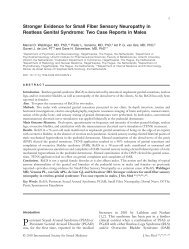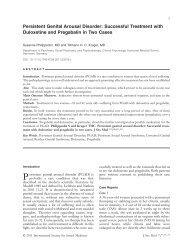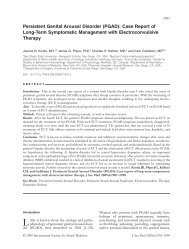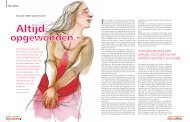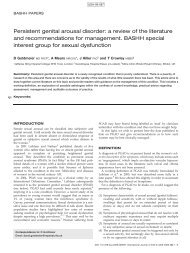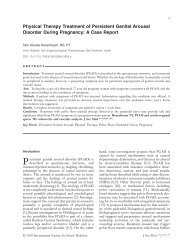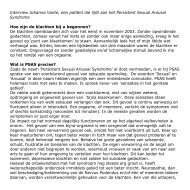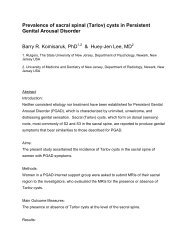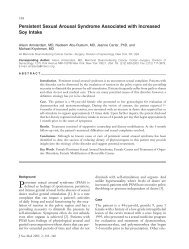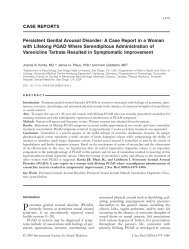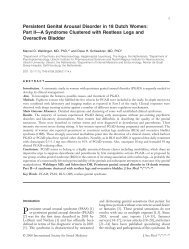Create successful ePaper yourself
Turn your PDF publications into a flip-book with our unique Google optimized e-Paper software.
September 6,2011<br />
<strong>Tarlov</strong> <strong>Cysts</strong><br />
(also known as perineural/perineurial) or<br />
sacral nerve root cysts)
Contents<br />
1. What is a <strong>Tarlov</strong> Cyst<br />
2. Difference between valved and non-valved cyst<br />
3-4. Symptoms<br />
5. Magnetic Resonance Imaging<br />
6-7. MRI images<br />
8. Asymptomatic cysts to symptomatic cysts<br />
9. Causes<br />
10. Treatment<br />
11. Bibliography
What are <strong>Tarlov</strong> <strong>Cysts</strong>?<br />
- fluid-filled nerve root cysts<br />
- most commonly in the sacral level of the spine<br />
- typically occur along the posterior nerve roots<br />
- can be valved or nonvalved<br />
- distinguishing feature is presence of spinal nerve root<br />
fibers within the cyst wall, or in the cyst cavity itself
What is a valved and non-valved<br />
cyst?<br />
A valved cyst has a structure in its neck that makes<br />
it easier for spinal fluid to enter the cyst than to<br />
leave.<br />
A non-valved cyst, spinal fluid flows freely between<br />
the cyst and the dural tube.
Symptomatic <strong>Tarlov</strong> <strong>Cysts</strong><br />
Symptoms:<br />
● Pain in the area of the nerves affected by the cysts, especially the<br />
buttocks<br />
● Weakness of muscles<br />
● Difficulty sitting for prolonged periods<br />
● Loss of sensation on the skin<br />
● Neurogenic claudication (pain in thigh due to lack of blood<br />
supply)
Symptomatic <strong>Tarlov</strong> <strong>Cysts</strong> (continued)<br />
● Changes in bowel function such as constipation<br />
● Changes in bladder function including increased<br />
frequency or incontinence<br />
● Loss of reflexes<br />
● Changes in sexual function<br />
● Parathesias (abnormal sensations) in legs and feet or arms<br />
and hands, dependent on cyst locations
Imaging of <strong>Tarlov</strong> <strong>Cysts</strong><br />
Magnetic Resonance Imaging (MRI) - dilated or<br />
ballooned areas of the sheaths that cover nerve roots<br />
exiting from the sacral region of the spinal column<br />
<strong>Cysts</strong><br />
- created by the dilated sheaths of the nerve roots<br />
- connected to the subarachnoid area<br />
of the spinal column<br />
- filled with cerebrospinal fluid
T-2 Weighted Imaging Preferred over T-1<br />
Weighted Imaging<br />
T 1<br />
-weighted scans are:<br />
● standard basic scan<br />
● differentiate fat from<br />
water (water darker and<br />
fat lighter)<br />
T 2<br />
-weighted scans are:<br />
● standard basic type<br />
● differentiate fat from<br />
water ( fat darker and<br />
water lighter)<br />
For example, CSF<br />
(cerebrospinal fluid) will be<br />
lighter in T 2<br />
-weighted<br />
images.
MRI image showing a <strong>Tarlov</strong> cyst.<br />
Source: http://wiki.ask.com/<strong>Tarlov</strong>_cyst
MRI sagittal image of sacral and dorso-lumbar perineural cysts<br />
Source: http://en.wikipedia.org/wiki/File:<strong>Tarlov</strong>_<strong>Cysts</strong>-Sagittal_MRI.JPG
Asymptomatic <strong>Cysts</strong> Can Become Symptomatic<br />
due to traumatic injuries:<br />
● falls<br />
● automobile accidents<br />
● heavy lifting<br />
● childbirth<br />
● epidurals
Causes of <strong>Tarlov</strong> <strong>Cysts</strong><br />
● Trauma to the spinal cord<br />
● An increase in the CSF pressure<br />
● A blockage of the CSF<br />
● Herpes Simplex Virus outbreak can cause symptoms to<br />
worsen
Other Imaging Techniques<br />
Myelogram or Computed Tomography (CT)<br />
- demonstrates the Cerebrospinal Fluid (CSF)<br />
flow between the spinal subarachnoid area and the cyst<br />
- determines how rapidly the cyst is filling and<br />
whether or not the fluid is freely flowing in and/or<br />
out of the cyst
Treatment for <strong>Tarlov</strong> <strong>Cysts</strong><br />
The cyst is opened and the cerebrospinal fluid drained<br />
To prevent the fluid from returning, the cyst is occluded<br />
with a fibrin glue injection
Bibliography<br />
http://www.tarlovcystfoundation.org/<strong>Tarlov</strong>CystInformation.asp<br />
http://wiki.answers.com/Q/What_are_<strong>Tarlov</strong>_cysts<br />
http://www.aans.org/JNSPG American Association of Neurological<br />
Surgeons Article ID: 14496<br />
http://go.galegroup.com (McCann Virtual Library)<br />
http://drmorgan.info/Clinicians/<strong>Tarlov</strong>sCyst.pdf<br />
http://www.buzzle.com/articles/tarlov-cysts.html



